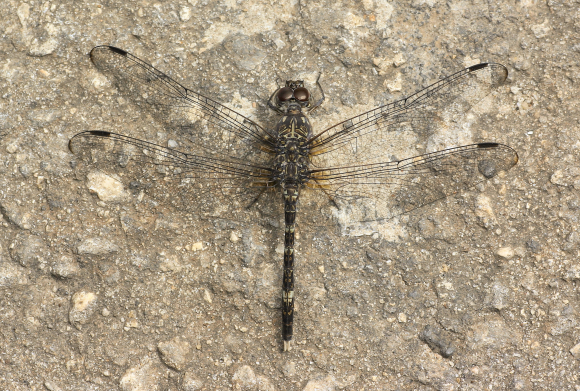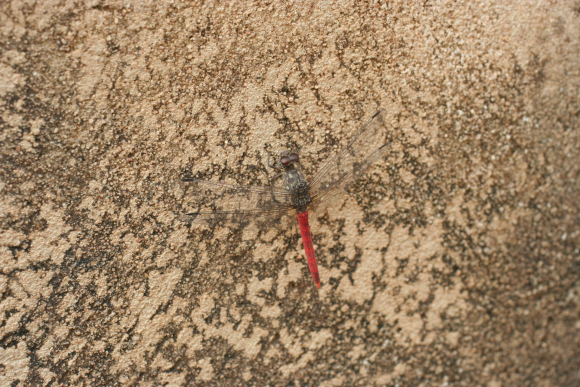Genus Bradinopyga Kirby, 1893
rockdwellers
Synonyms:
- scientific: Apeleutherus Kirby, 1900 [strachani]
Type species: Bradinopyga stigmata Kirby, 1893 [= B. geminata (Rambur, 1842)]
Introduction
The two African and one Asian species are related to Crocothemis but are fairly large (hindwing 31-42 mm) with speckled bodies and the vertex bears two sharp points. In most areas only one species is found, the red B. strachani in central and western Africa, and the brown B. cornuta in eastern and southern Africa, but they overlap from western Kenya and Uganda to Katanga. Both species reproduce in rock pools filled by rain or flood water, as well as in their artificial equivalents, such as concrete basins and open water tanks. They typically settle on boulders and walls, their intricate markings matching the mottled surface of rock and lichens. [Adapted from Dijkstra & Clausnitzer 2014]
Diagnosis
Male of genus is similar to Crocothemis by (a) labium pale, legs at most with blackish tarsi; (b) hindlobe of prothorax small, roughly semicircular and widest at base (dorsal view), apex often pressed downwards (lateral view), its border with short hairs and at most a few longer hairs; (c) Fw discoidal field widens terminally, number of cell-rows just before end about double that at base, e.g. 3 and 6; (d) 8½-19½ Ax in Fw (‘½’ indicates often incomplete distal Ax); (e) sectors of arculus in Fw always fused at base, separating well distal to arculus; (f) arculus often closer to Ax2, sometimes even distal to it; (g) hook of hamule small, placed midway along large lobe which dwarfs and often conceals it; (h) anterior lamina low, much smaller than genital lobe; (i) S4 without transverse ridge, although colour pattern or scar-like seam may indicate its position, there is no ridge of similar magnitude as transverse ridge of S3 and lateral carina of S4. However, differs by (1) relatively larger size, Hw 31-42 mm; (2) vertex high rather than low, drawn out into 2 sharp horn-like apices; (3) 2 and often even partly 3 cell-rows in radial planate; (4) arculus in all wings usually closer to Ax1 than Ax2. [Adapted from Dijkstra & Clausnitzer 2014; this diagnosis not yet verified by author]

Bradinopyga cornuta Ris, 1911. Male © Allan Brandon

Bradinopyga strachani (Kirby, 1900). Male © Olivier Esnault
Map citation: Clausnitzer, V., K.-D.B. Dijkstra, R. Koch, J.-P. Boudot, W.R.T. Darwall, J. Kipping, B. Samraoui, M.J. Samways, J.P. Simaika & F. Suhling, 2012. Focus on African Freshwaters: hotspots of dragonfly diversity and conservation concern. Frontiers in Ecology and the Environment 10: 129-134.
References
- Dijkstra, K.-D.B, and Clausnitzer, V. (2014). The Dragonflies and Damselflies of Eastern Africa: handbook for all Odonata from Sudan to Zimbabwe. Studies in Afrotropical Zoology, 298, 1-264.
- Ris, F. (1921). The Odonata or Dragonflies of South Africa. Annals South African Museum, XVIII, 245-452. [PDF file]
- Pinhey, E.C.G. (1961). Dragonflies (Odonata) of Central Africa. Occasional Papers Rhodes-Livingstone Museum, 14, 1-97. [PDF file]
- Kirby, W.F. (1900). Report on the Neuroptera Odonata collected by Mr E. E. Austen at Sierra Leone during August and September 1899. Annals Magazine Natural History, 6, 67-79. [PDF file]
Citation: Dijkstra, K.-D.B (editor). African Dragonflies and Damselflies Online. http://addo.adu.org.za/ [2024-10-30].

